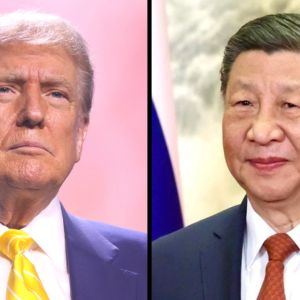US president Donald Trump has slapped China with another 10% tariff on imports, adding to an earlier 10% tariff imposed around a month ago. The latest duties, announced suddenly on Friday via Truth Social as per usual, will take effect on March 4. China’s Ministry of Commerce responded within hours, warning that it will take “all necessary measures” to protect its economy. “If the US insists on having its own way, China will counter with all necessary measures to defend its legitimate rights and interests,” a Ministry of Commerce spokesperson said, per a report from Bloomberg News. The statement follows Beijing’s past commitment to take “corresponding steps” in response to Washington’s economic measures. Markets take a hit as investors react The market reaction was immediate. Hong Kong-listed Chinese stocks plunged 3.9% Friday morning, which is their worst single-day loss since October. The CSI 300 Index, which tracks the largest companies on the mainland, dropped 1.9%, ending its longest winning streak in a month. The offshore yuan briefly fell overnight before recovering 0.1% to 7.29 per dollar, as the People’s Bank of China stepped in to stabilize the currency, per data from MarketWatch. Bond yields across China also slumped as economic concerns grew. Investors, already on edge about Trump’s trade policies, reacted to the sudden tariff announcement by moving funds into safer assets. The People’s Bank of China has been working to support the financial system, but rising borrowing costs and tightening liquidity have raised concerns about economic stability. The timing of the tariffs adds a lot of pressure on China’s President Xi Jinping as the duties will go into effect just one day before Xi and his top officials gather for the National People’s Congress, the most important political meeting of the year. There, his government will unveil its economic blueprint for 2025, outlining key policies on trade, domestic growth, and financial stability. While the tariffs won’t force a change in China’s official economic targets, they could dampen sentiment. At a Friday meeting, Xi and his Politburo talked about the need to expand domestic demand and stabilize financial markets—two topics that are expected to dominate discussions next week. Despite escalating tensions, Xi has urged his team to remain calm, likely due to the fact that he and Trump like each other a lot and have said so on many occasions. The Chinese leader has yet to speak with Trump since his return to office, even though the US president has repeatedly said that a conversation is expected soon. But high-level talks between Chinese and American officials continue behind the scenes. Vice Premier He Lifeng met with US Treasury Secretary Scott Bessent last week in what was the second major dialogue since Trump’s inauguration. China’s Defense Ministry also confirmed that discussions with the US military are in the works. China’s countermeasures: Trade war tools ready China has a long history of striking back when tariffs take effect. In the last round of trade tensions, Beijing responded within seconds of Washington’s new duties kicking in. The measures included additional tariffs on US goods, an antitrust investigation into Google , and new restrictions on critical mineral exports that the US relies on. China also blacklisted major American companies, preventing them from doing business in the country. A similar response is expected this time, according to JPMorgan and Goldman Sachs economists. One major tool at China’s disposal is the suspension of US tariff waivers, which coincidentally expire today. These waivers have allowed certain US imports to enter China without facing retaliatory tariffs. While Beijing has previously extended these waivers, it has yet to announce an extension this time—strongly suggesting that they will be left to expire. The Trump administration is also tightening restrictions on China beyond tariffs. Over the past two weeks, Washington has announced new investment curbs, proposed shipping fees for goods transported on Chinese-made vessels, and has been pressuring Mexico to also impose tariffs on Chinese imports. For Americans and American businesses, the effect of the tariffs will be felt quickly. China remains the largest US trading partner on a single-country basis, and new duties mean higher costs for importers. The US Federal Reserve actually reported in January that official trade data underestimates how much the US actually imports from China. That means the actual price impact of these tariffs could be far worse than expected. Meanwhile, China’s financial system is facing its own set of challenges. The People’s Bank of China has been actively supporting the yuan, prioritizing currency stability over aggressive monetary easing. However, that decision has led to a liquidity crunch, with short-term borrowing costs surging. The yield on one-year AAA-rated negotiable certificates of deposit, a key funding instrument for banks, jumped past 2% this week—the highest since June. The central bank’s reluctance to inject more liquidity has driven borrowing costs even higher. The rate on one-year medium-term lending facility loans—the People’s Bank of China’s key policy tool—was surpassed for the first time since October, thanks to a tightening credit environment. Cryptopolitan Academy: Want to grow your money in 2025? Learn how to do it with DeFi in our upcoming webclass. Save Your Spot



















